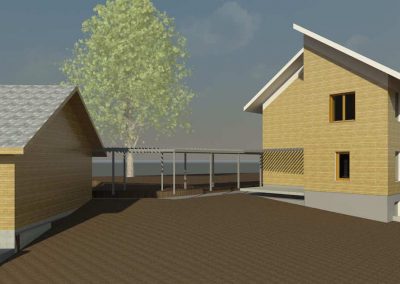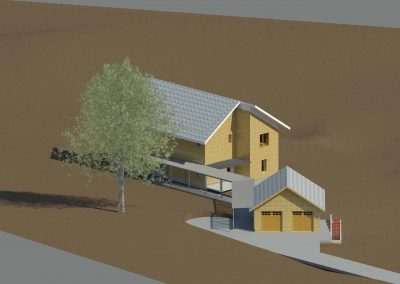Information
Phoenix Haus
Meet the Phoenix Haus. This house is a balance of locally-sourced materials and cutting-edge building science. The house takes comfort and air quality to a new level in residential design. Interior temperature is maintained at a comfortable 62 degrees throughout the year while energy costs are minimal thanks to super the super-insulated walls and air-tight building construction. Know as a Passive House, the building is heated primarily by passive solar gain (sun) and internal gain (people, electrical equipment, etc.). This contemporary craftsman fits well into its rural setting near Saginaw, Michigan.
Phoenix Haus was designed as a collaborative effort with certified Passive House Consultant, Bill McDonald, of Phoenix Home Performance, www.zerohomeenergy.com.
Four Tenets of Passive House
Solar Orientation
Each design starts with a site plan that accurately orients the main elevation of the building directly south for maximum solar gain potential. By harnessing the sun’s energy in the winter and managing it in the summer, Passive Houses can take advantage of the free and natural resource. Each Passive House is designed for its specific climate region.
Super-Insulated Envelope
By increasing the amount of insulation all around a Passive House, we can control temperature differentials through all four seasons maintaining a comfortable indoor environment 365 days a year. By using blown cellulose insulation a Passive House dramatically reduces the embodied energy compared to batt insulation or spray foam.
Air-Tight Construction
In concert with the insulation, the envelope of a Passive House is carefully constructed to minimize cracks and thermal bridges where air can infiltrate through the house. By dramatically reducing air leakage, a Passive House saves on energy costs that standard construction spends on reheating drafty homes. The air-tight layer of a Passive House acts like a balloon filled with water, eliminating leaks.
Fresh Air Ventilation
With all three of the above methods accomplished, the final step is to ventilate the Passive House efficiently. The best way to do this is with Heat Recovery Ventilation. This system takes 100% fresh air from the outside and preheats it with the exhaust stale air from the inside of the house. This quiet system replaces traditional fossil fuel burning forced air furnaces.




